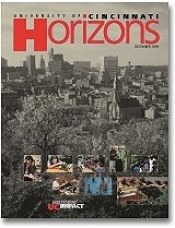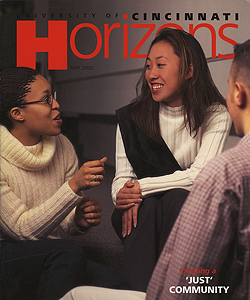Letters to the Editor

Hooray for the January 2000 issue of "Horizons." It's about time that we blew our own horn. Our alumni, the general public and state and local opinion leaders don't understand how big we are, how important we are and our enormous contributions. Let's keep explaining it to them. Good work.
Alfred Tuchfarber
Director of the UC Institute for Policy Research
I'm writing to tell you how incredible your current cover story in "Horizons" is ["Save a Life or Serve a Dinner," January 2000]. First of all, the topic is terrific. Someone would have to be dead and buried not to know that we have "neighbors" around our campus, many of whom would just as soon that we weren't there. But to see -- and read of -- what good (often great) work is being done by our students and faculty in the area was a brilliant topic. And I especially enjoyed the way you set up the "side-bars" throughout the piece.
Larry Patterson, A&S '66
New York City
I just finished checking out the Web site's two special pages on the Institute for Learning in Retirement. It all should help greatly in recruiting new students for the wonderful program.
Incidentally, a very large number of UC alumni participate both as students and as moderators. And ILR will celebrate with a 10th anniversary event on May 13 at the Kingsgate Conference Center.
"Horizons" continues to be both attractive and informative. Keep up the good work!
Morris (Morrie) Fogel, A&S '49
Cincinnati
Editorial missed mark
I read your article "Let's Look at the Ratings'' with much interest and some amusement. The "U.S. News" ranking is a problem for UC, and that situation will not change until the situation at UC changes.
Bashing the ranking system is exactly the opposite thing that UC should be doing, but is so like the UC that I remember -- a kind of militant attitude against all who dare criticize the system. Has anyone stopped to think that this habit of telling critics to go away is exactly why UC finds itself in the situation that it is in today?
Your article mentioned that the "U.S. News" ranking system is unfair because, for example, it takes into consideration the rate of alumni donations. Well, what is wrong with that?
I would say that the rate of alumni donations is an excellent gauge of how the alumni feel about their university experience after they have moved on in life. What UC might gather from this low rate of giving is that a whole lot of alumni are not happy with their UC experience.
Certainly, I can't read all of these people's minds to find out what these grievances might be; however, I can remember what my time at UC was like. There seemed to always be conflicts between the professors, administrators and the support staff. The students were not, and I suspect are not today, the center of the university's concerns. They just had to slug through everything thrown at them.
The article mentioned that UC is a "Carnegie Commission Research I University,'' and we all know that UC has a great basketball team. To these type of things, I say so what! All of these titles in the world will not improve UC's ranking or reputation, nor will it make the paying customers (the students) happier with their UC experience. Professors and administrators who are interested in their students' education, however, will.
Certainly, UC has a lot to offer a potential student. But if I could apply a paraphrase to UC's situation wherein Bill Clinton was speaking on the topic of being a public figure: "It's a great thing, if you can deal with the pain threshold."
So, do us all a favor and take this "U.S. News" ranking seriously and fix the problem!
Adam Hutson, DAAP '92
Dortmund, Germany
More on editorial ...
I read the editorial ("Let's Look at the Ratings") regarding UC's rankings in "U.S. News and World Report." I would like to correct a factual error. Ohio State and Miami are not ranked as Tier-I schools; they are ranked Tier II. Many fine schools, such as Indiana and Purdue are ranked as Tier II, and I do find it interesting that UC could not make the list.
In my opinion, the editorial sounds as if UC has an inferiority complex, and I do not like that. The fact of the matter is that many people do read the rankings or else "U.S. News" would not publish them every year. A recent "Wall Street Journal" article addressed the issue of rankings and how they affect attitudes towards universities. To downplay rankings does not serve UC well.
UC has many things going for it, but if you look at other rankings, particularly the elite ones, UC is often excluded. Hopefully much of what is happening on campus today will erase UC's reputation as a third-tier commuter school.
I suppose the best thing for the university to do is aggressively promote its positive points and correct those things which cause the school to perform poorly in the rankings. Maybe then, alumni monetary support will fare favorably with other schools.
Steve Luehrmann, BusAd '85
Cincinnati
Editor's note: Steve Luehrmann is right. We made a jump-off-the-page-and-choke-you mistake regarding Ohio State and Miami universities. Our editorial was in response to a previous letter to the editor (UC deserves better). We attempted to explain that Miami and OSU had attained higher rankings than UC by being placed on lists that were less restrictive and less prestigious than the list UC had nabbed. Unfortunately, we incorrectly referred to the other schools as having first-tier rankings. They didn't. They were in the second tier of "regional" rankings, while UC was in the third tier of "national" rankings. In trying to clarify a complex issue, we only muddied things more.
As a point of clarification, the editorial did not state the ranking system was unfair, although some readers certainly believed the implication was there. The original editorial ("Let's Look at the Ratings") is posted in a corrected form (thanks to Steve).
Basketball stats questioned
I understand, from what I read in the newspapers, that the current coach of the men's basketball team has the dubious record of not having had a single one of his players ever graduate! Could this possibly be true? Surely not! Or do we stoop so low as to "hire" athletes to play for U.C., and then let them go when their eligibility is up? This is not what I would expect from an institute of higher learning.
Hopefully, you'll tell me I'm wrong and that almost all the ballplayers do graduate and I can care what the Bearcats do, once again.
Patricia K. Fieno, CN&H '59
Charlotte, N.C.
Editor's reply: The subject is a bit more complex than most media are willing to explain. Here is why: The NCAA tracks graduation rates for entering freshmen who finish their degrees within a six-year window. By that standard, Coach Bob Huggins has not had any players graduate.
However, of the 33 players who finished their college careers under Huggins prior to the 1999-2000 season, 15 of them had attained their degree. The reason for the discrepancy is this: First of all, UC recruits many players from junior colleges. Those students, since they didn't enter UC as freshmen, can't be counted. Second, players often graduate, but simply not within the allotted six-year time frame. This is not exactly an uncommon occurrence even for UC's non-athlete population of students. Finally, several players under Huggins have postponed their academic pursuits to play professional basketball either in the United States or abroad.

 Past Issues
Past Issues